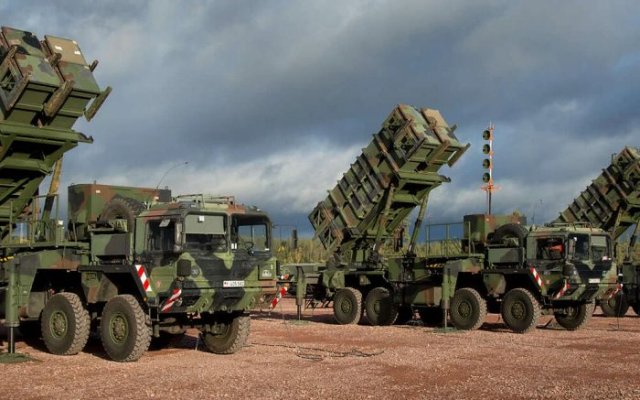
Patriot air defense system The conflict in Ukraine has predictably turned into a fierce confrontation between the military potential of the United States and NATO countries with the Russian one.
The situation has significantly worsened with the beginning of the massive use of kamikaze attack drones by the Russian Aerospace Forces in conjunction with cruise missiles of various classes at industrial and military infrastructure facilities. It became obvious that the existing air defense system of Ukraine is not able to protect the country's strategic facilities, and therefore its leadership appealed to the US administration with a request for the supply of Patriot air defense systems, and it was satisfied.
How justified are the hopes of the country's political leadership and the AFU command for the coveted Patriot, and will it be able to compete with the Russian S-300 and S-400 Triumph air defense systems?
From SAM-D SAM to Patriot
With the advent of ballistic missiles in the late 50s, it became necessary to create a means of combating them. In 1964, the Pentagon announced the development of the SAM-D anti-missile system. However, at that time its future characteristics were not quite clear. Three years later, the contractor of the project, Raytheon, was determined, and in 1969 the first launches took place. Over the next seven years, changes were made to the system, including the name — in early 1976, it was renamed from SAM-D to XMIM-104A, and a few months later it finally acquired its current name — "Patriot".
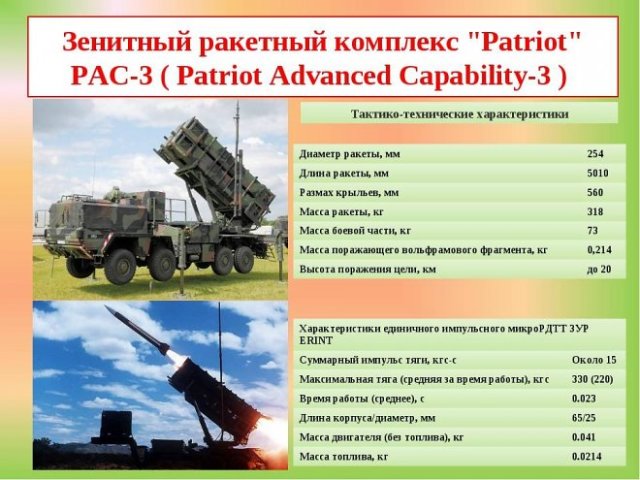
TTX SAM "Patriot" The first Patriot air defense system battery entered NORAD (United American-Canadian Air Defense Command) only in 1984.
Since then, the complex has been upgraded three times, as a result, updated versions of the Patriot appeared — RAS-1 (1985), RAS-2 (1987) and RAS-3 (2001).
Composition and tactical and technical characteristics of the Patriot RAS-3 air defense system
The complex is capable of intercepting aerodynamic (aircraft, KR) and ballistic targets, including warheads in the passive area, including those made using stealth technology. The complex includes:
- Control Center — AN/MSQ-104;
- 8 M901 launchers;
- Anti-aircraft guided missiles — MIM104 A (for aerodynamic targets), MIM 104 B (for passive targeting of jammers and radars), MIM 104 C/D/E (for intercepting ballistic targets);
- AN/MJQ-20 Autonomous Power Plant;
- Means of communication — AN/MCR-137 radio relay stations with antenna-mast devices;
- Auxiliary equipment — transport-charging machines, mobile PTO, cars and a tractor with a crane;
- Means of radio technical disguise.
The detection, tracking of targets, targeting and control of missiles in flight is implemented by the Track-Via-Missile method ("tracking through a rocket") is performed by the AN/MSQ-65 multifunctional radar with a phased array antenna (FAR).
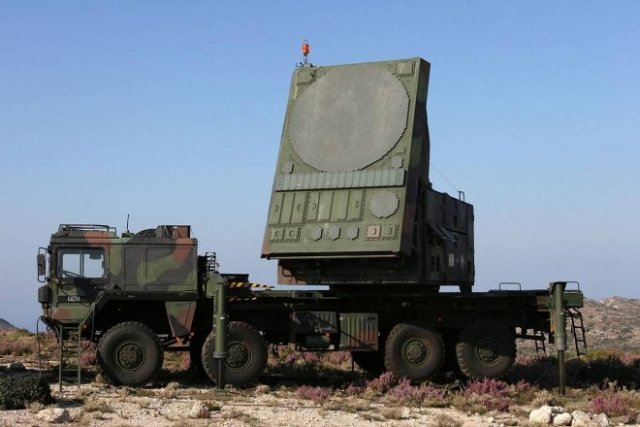
Multifunctional radar AN/MSQ-65 Having received the target designation, the calculation deploys the radar in the direction of the enemy aircraft with the possibility of changing the azimuth position.
Synchronously with the radar, the launcher is deployed. The fixed angle of the rocket launch is 38 degrees relative to the horizon line. The launched missile defense system captures the radar signal reflected from the target and transmits it to the KP. The radar receives two reflected signals simultaneously — its own and from the missile defense system, after which the SAM computer, comparing both signals, "builds" the flight path.
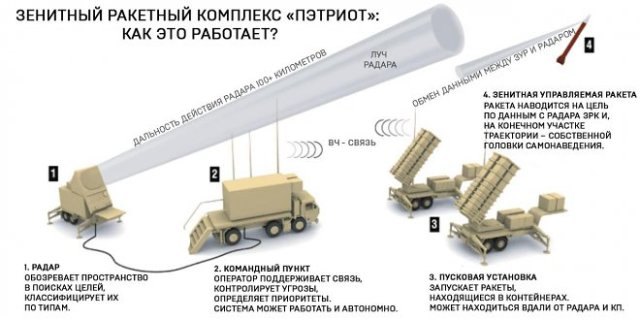
The work of the Patriot air defense system The complex can accompany up to 125 targets, while firing — only up to 8, including targets flying at a speed of Mach 2.
The detection range of warheads of missiles, missiles, fighters and bombers is 70, 100, 130 and 180 km, respectively. The SAM unfolds in 25 minutes. The complex hits targets at an altitude of 60 m to 25 km. Ballistic targets are destroyed at a range of up to 20 km and aerodynamic targets — up to 80 km.
Anti-aircraft guided missile
Its first version, the MIM—104A "Standard", was intended exclusively for the destruction of aircraft — a range of up to 70 km, a speed of Mach 2. The subsequent MIM-104C RAS-2 was already "hunting" for bigger "game" — ballistic missiles. And the improved RAS-3 with an active homing head already destroyed targets not by detonating a shrapnel warhead, but by a direct hit.
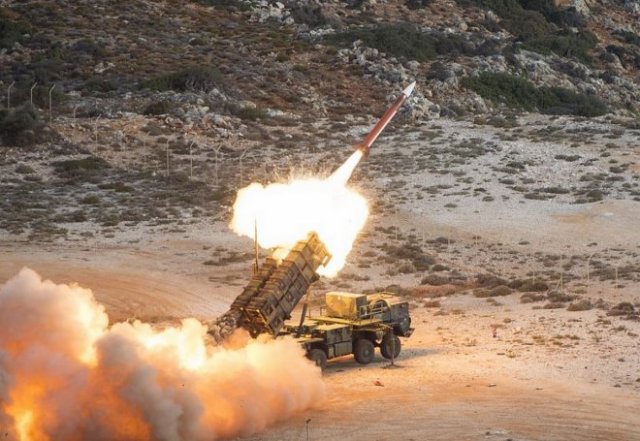
Launch of the Patriot SAM missile Having a standard design, the RAS-2 missiles are distinguished by an internal filling.
The rocket consists of front and rear fairings, guidance compartments, warhead, engine, and control drive.
Technical specifications:
- Weight (RAS-3/RAS-3 MSE) — 312/373 kg;
- Length — 5200/4826 mm;
- Diameter — 255/300 mm;
- Warhead weight — 90 kg;
- Fuse — contactless;
- Fuel — solid;
- The maximum speed of the RAS-2/RAS-3 is Mach 4.1.
The missiles are located on the M901/902/903 self-propelled launchers, which are autonomous devices with remote control. Each PU is installed and fixed in azimuth at an angle of up to 10 degrees. Precise guidance is not required before launch. PU act as part of batteries, which include from 4 to 8 installations. In turn, the batteries can be combined into divisions.
Combat use of the Patriot air defense system
The baptism of fire of the complex in early 1991 during Operation Desert Storm against the Iraqi Air Force proved to be a failure. An analysis of the use of the complex published by Professor Theodore Postol of the Massachusetts Institute of Technology showed that none of the 40 Scud missiles launched by Iraq was intercepted. In particular, a software error during one of the interception attempts led to the defeat of an Iraqi missile barracks with American soldiers in Saudi Arabia and the death of 28 soldiers.
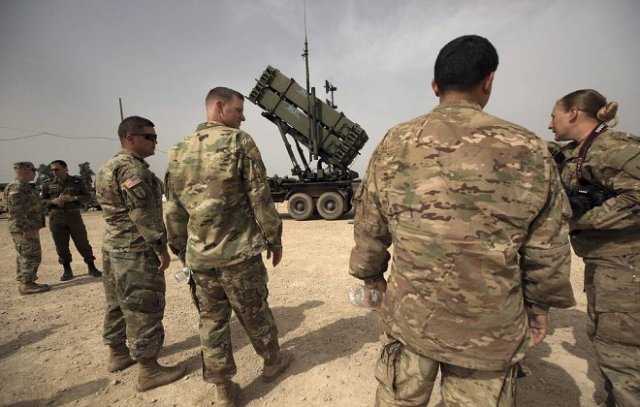
Calculation of the Patriot air defense system in Iraq 12 years later, during Operation Iraqi Freedom, the use of the Patriot air defense system proved to be more successful.
Then it was possible to intercept most of the Iraqi ballistic missiles. However, it was not without incidents. So, as a result of the "friendly" fire of one of the calculations, a Tornado fighter of the British Air Force was shot down. And just a day later, the pilot of the F-16 fighter of the US Air Force mistakenly destroyed the radar of his complex. As part of the Israel Defense Forces, Patriot air defense systems participated in Operation Unbreakable Rock in 2014, when they managed to intercept several UAVs belonging to the Hamas organization. Later, from 2014 to 2018, they were used several times during the armed conflict in Syria. Patriot's track record includes participation in conflicts between Saudi Arabia, the UAE and Yemeni Houthi rebels. The complex protects the airspace of Jordan, Kuwait, South Korea, Morocco, the Netherlands, Qatar, Romania, Sweden, Spain, Germany, Taiwan, the UAE, Poland. It is possible that after the preparation of calculations, the Patriot air defense system will be part of the Armed Forces of Ukraine.
Russia and the USA: whose air defense systems are better
The special military operation in Ukraine, where air defense systems are actively used on both sides, has once again intensified the discussion that has been going on for decades about whose air defense systems are better — Russian or American. The problem is that air defense systems do not lead a direct confrontation with each other. Everything is decided by efficiency in specific duels with an aerial opponent. By about 2010, experts gave the palm to the American "Patriot". However, with the adoption of the S-300 PM2 "Favorit" and S-400 "Triumph" sams, the situation has changed dramatically in favor of Russia. The S-400 ammunition includes several types of anti-aircraft guided missiles capable of hitting various ballistic and aerodynamic targets. The 91 N6E early detection radar detects large targets at a range of up to 600 km, and medium—range missile blocks - up to 200-230 km. Being equipped with the 91L6E high-altitude radar, the complex detects targets at an altitude of up to 100 km, i.e. already in near space. The S-400 can operate as part of an echeloned air defense group. The missiles of the 48N6E complex (E2, E3) are equipped with warheads weighing 145, 150 and 180 kg and destroy targets at ranges from 150 to 250 km at altitudes up to 27 km. Of particular interest is the 40N6E extended-range missile with a range of up to 400 km and a height of up to 30 km.
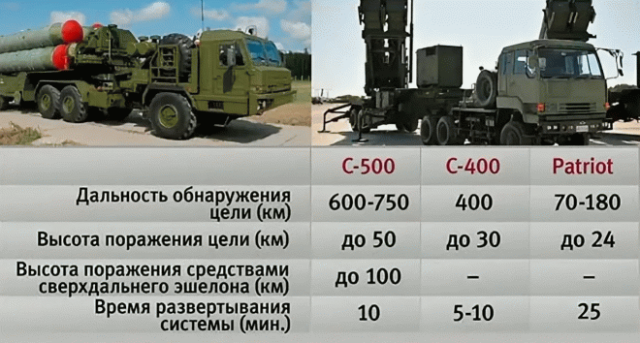
Comparative characteristics of the Russian and US air defense systems The complex is capable of firing at up to 80 targets using 160 missiles.
Unlike the Patriot SAM, the S-400 has a vertical start followed by a turn in the direction of the target. Against the background of such impressive characteristics, the capabilities of the Patriot air defense system look very modest. The latest versions of the missiles are equipped with a warhead weighing 91 kg, the maximum firing range is limited to 100 km, and for ballistic targets — 20 km at a height of damage from 100 m to 25 km.
It is not in favor of the "American" and the fact that he is older than the Russian counterpart by more than 15 years. Its dubious effectiveness was once again recalled by a scandalous episode when several drones of Yemeni Houthi rebels freely attacked the Saudi Aramco oil refineries in Saudi Arabia, which were guarded by a Patriot air defense system battery.
Taking the most active part in the SVO, the Russian S-300 PM-2 Favorit systems and its "brothers" from military air defense — Tor, Buk-M3 and ZRPC Pantsir-S, hit all types of targets without exception — airplanes, helicopters, tactical missiles, UAVs, MLRS rockets, including from HIMARS. It is obvious that Patriot is absolutely powerless against the latest Russian strategic missile systems and hypersonic missiles Dagger and Zircon. And moreover, it does not go to any comparison with the latest Russian S-500 air defense system.
Alexander Ageev
